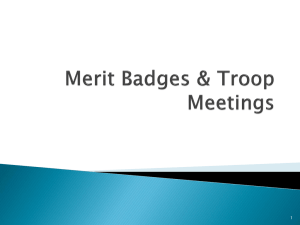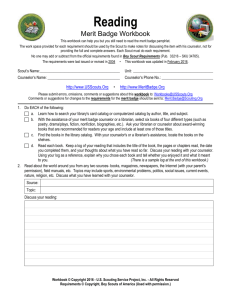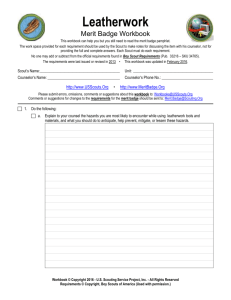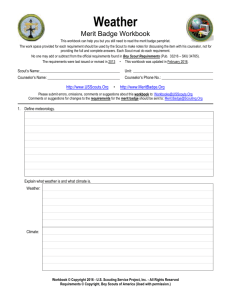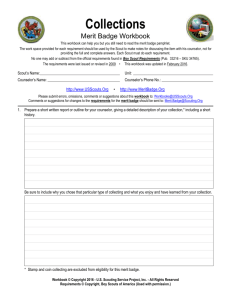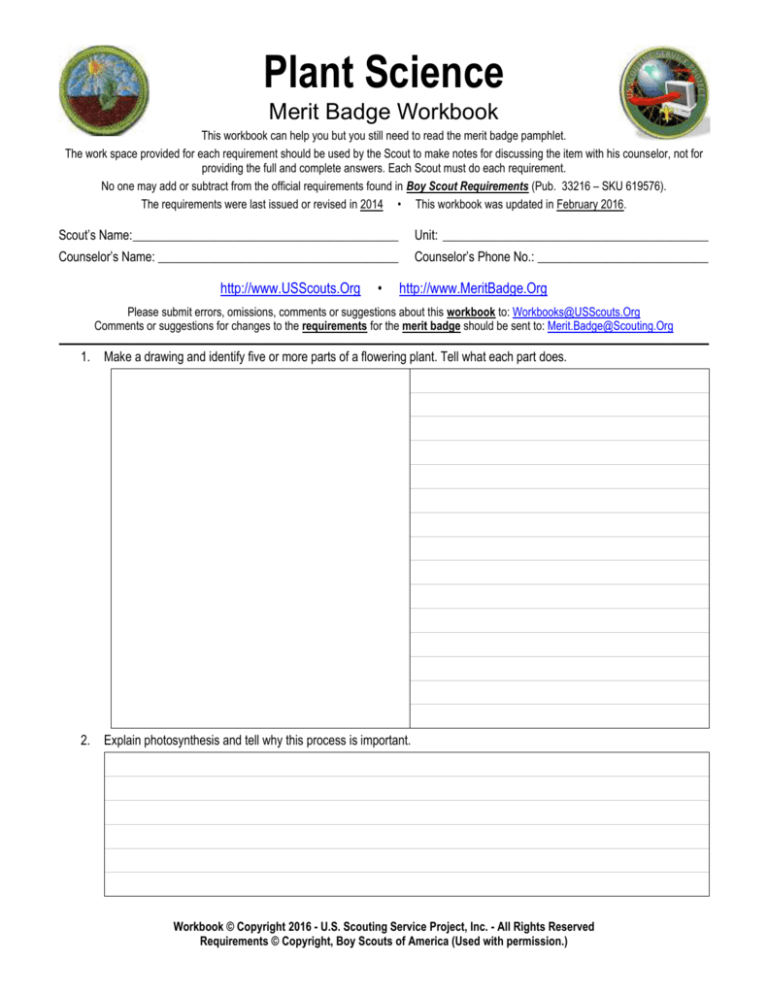
Plant Science
Merit Badge Workbook
This workbook can help you but you still need to read the merit badge pamphlet.
The work space provided for each requirement should be used by the Scout to make notes for discussing the item with his counselor, not for
providing the full and complete answers. Each Scout must do each requirement.
No one may add or subtract from the official requirements found in Boy Scout Requirements (Pub. 33216 – SKU 619576).
The requirements were last issued or revised in 2014 • This workbook was updated in February 2016.
Scout’s Name:__________________________________________
Unit: __________________________________________
Counselor’s Name: ______________________________________
Counselor’s Phone No.: ___________________________
http://www.USScouts.Org
•
http://www.MeritBadge.Org
Please submit errors, omissions, comments or suggestions about this workbook to: Workbooks@USScouts.Org
Comments or suggestions for changes to the requirements for the merit badge should be sent to: Merit.Badge@Scouting.Org
______________________________________________________________________________________________________________________________________________
1. Make a drawing and identify five or more parts of a flowering plant. Tell what each part does.
2. Explain photosynthesis and tell why this process is important.
Workbook © Copyright 2016 - U.S. Scouting Service Project, Inc. - All Rights Reserved
Requirements © Copyright, Boy Scouts of America (Used with permission.)
Plant Science
Scout's Name: ________________________
Tell at least five ways that humans depend on plants.
1.
2.
3.
4.
5.
5. Explain how honeybees and other pollinating insects are important to plant life.
4. Explain how, light, air, temperature, and pests affect plants.
Water:
Light:
Plant Science - Merit Badge Workbook
Page. 2 of 11
Plant Science
Scout's Name: ________________________
Air:
Temperature:
Pests:
Describe the nature and function of soil and explain its importance.
Nature
Function
Importance
Tell about the texture, structure, and composition of fertile soil.
Texture
Plant Science - Merit Badge Workbook
Page. 3 of 11
Plant Science
Scout's Name: ________________________
Structure,
Composition:
Tell how soil may be improved.
5. Tell how to propagate plants by seeds, roots, cuttings, tubers, and grafting.
Seeds:
Roots:
Cuttings:
Tubers:
Plant Science - Merit Badge Workbook
Page. 4 of 11
Plant Science
Scout's Name: ________________________
Grafting:
Grow a plant by ONE of these methods.
6. List by common name at least 10 native plants and 10 cultivated plants that grow near your home.
10 native plants
1.
6.
2.
7.
3.
8.
4.
9.
5.
10.
10 cultivated plants
1.
6.
2.
7.
3.
8.
4.
8.
5.
10.
List five invasive nonnative plants in your area and tell how they may be harmful.
1.
2.
3.
4.
5.
Tell how the spread of invasive plants may be avoided or controlled in ways that are not damaging to humans, wildlife,
and the environment.
Plant Science - Merit Badge Workbook
Page. 5 of 11
Plant Science
Scout's Name: ________________________
7. Name and tell about careers in agronomy, horticulture, and botany.
Agronomy
Horticulture
Botany
Write a paragraph about a career in one of these fields that interests you.
Plant Science - Merit Badge Workbook
Page. 6 of 11
Plant Science
Scout's Name: ________________________
8. Choose ONE of the following options and complete each requirement:
(Use blank paper for your notes on each item.)
Option 1: Agronomy
A.
Describe how to prepare a seedbed.
B. Make and use a seed germination tester to test 50 seeds of four of the following plants: corn, cotton, alfalfa,
soybeans, clover, wheat, rice, rye, barley. Determine the percentage of live seeds.
C. Tell about one important insect pest and one important disease that damage each of the following: corn, small
grains, cotton. Collect and name five weeds that compete with crops in your locality. Tell how to control these
weeds without harming people, wildlife, or useful insects.
D. On a map of the United States, identify the chief regions where corn, cotton, forage crops, small grain crops,
and oil crops grow. Tell how climate and location of these regions make them leaders in the production of these
crops.
E.
Complete ONE of the following alternatives:
1. Corn
a. Grow a plot of corn and have your plot inspected by your counselor. Record seed variety or
experimental code number.
b. Tell about modern methods of commercial corn farming and the contributions that corn makes to
today’s food and fuel supply.
c. Tell about an insect that can damage corn, and explain how it affects corn production and how it is
controlled.
2. Cotton
a. Grow a plot of cotton and have your plot inspected by your counselor.
b. Tell about modern methods of commercial cotton farming, and about the uses of cotton fiber and
seed and the economic value of this crop.
Plant Science - Merit Badge Workbook
Page. 7 of 11
Plant Science
Scout's Name: ________________________
c. Tell about an insect that can damage cotton, and explain how it affects cotton production and how
it is controlled.
3. Forage Crops
a. Collect, count, and label samples of each for display: perennial grasses, annual grasses, legumes,
and broadleaf weeds. Indicate how each grass and legume is used. Keep a log of the site where
you found each sample and share it with your counselor.
b. Explain how legumes can be used to enrich the soil and how they may deplete it under certain
conditions. Explain how livestock may enrich or deplete the soil.
c. Name five poisonous plants that are dangerous to livestock, and tell the different ways of using
forage crops as feed for livestock.
4. Small Grains
a. Give production figures for small grain crops listed in the U.S. Statistical Report or Agricultural
Statistics Handbook for the latest year available.
b. Help in harvesting a crop of grain. Tell how to reduce harvesting losses and about modern
methods of growing one small grain crop.
c. Visit a grain elevator, flour mill, cereal plant, feed or seed company. Talk with the operator. Take
notes, and describe the processes used and tell your patrol, troop, or class about your visit.
5. Oil Crops
a. Grow a plot of soybeans and have your plot inspected by your counselor.
b. Tell about modern methods of growing soybeans on a commercial scale, and discuss the
contributions soybeans make to our food supply.
c. Explain why a killing frost just after emergence is critical for soybeans.
Option 2: Horticulture
A. Visit one of the following places and tell what you learned about horticulture there: public garden, arboretum,
retail nursery, wholesale nursery, production greenhouse, or conservatory greenhouse.
B. Explain the following terms: hardiness zone, shade tolerance, pH, moisture requirement, native habitat, texture,
cultivar, ultimate size, disease resistance, habit, evergreen, deciduous, annual, perennial. Find out what
hardiness zone you live in and list 10 landscape plants you like that are suitable for your climate, giving the
common name and scientific name for each.
C. Do ONE of the following:
1. Explain the difference between vegetative and sexual propagation methods, and tell some horticultural
advantages of each. Grow a plant from a stem or root cutting or graft.
2. Transplant 12 seedlings or rooted cuttings to larger containers and grow them for at least one month.
3. Demonstrate good pruning techniques and tell why pruning is important.
4. After obtaining permission, plant a tree or shrub properly in an appropriate site.
D. Do EACH of the following:
1. Explain the importance of good landscape design and selection of plants that are suitable for particular
sites and conditions.
2. Tell why it is important to know how big a plant will grow.
3. Tell why slower-growing landscape plants are sometimes a better choice than faster-growing varieties.
E. Choose ONE of the following alternatives and complete EACH of the requirements:
1. Bedding Plants
a. Grow bedding plants appropriate for your area in pots or flats from seed or cuttings in a
manufactured soil mix. Explain why you chose the mix and tell what is in it.
b. Transplant plants to a bed in the landscape and maintain the bed until the end of the growing
season. Record your activities, observations, materials used, and costs.
Plant Science - Merit Badge Workbook
Page. 8 of 11
Plant Science
Scout's Name: ________________________
c. Demonstrate mulching, fertilizing, watering, weeding, and deadheading, and tell how each
practice helps your plants.
d. Tell some differences between gardening with annuals and perennials.
2. Fruit, Berry, and Nut Crops
a. Plant five fruit or nut trees, grapevines, or berry plants that are suited to your area. Take full care
of fruit or nut trees, grapevines, or berry plants through one season.
b. Prune a tree, vine, or shrub properly. Explain why pruning is necessary.
c. Demonstrate one type of graft and tell why this method is useful.
d. Describe how one fruit, nut, or berry crop is processed for use.
3. Woody Ornamentals
a. Plant five or more trees or shrubs in a landscape setting. Take full care of the trees or shrubs you
have planted for one growing season.
b. Prune a tree or shrub properly. Explain why pruning is necessary.
c. List 10 trees (in addition to those listed in general requirement 5 above) and tell your counselor
how each is used in the landscape. Give the common and scientific names.
d. Describe the size, texture, color, flowers, leaves, fruit, hardiness, cultural requirements, and any
special characteristics that make each type of tree or shrub attractive or interesting.
e. Tell five ways trees help improve the quality of our environment.
4. Home Gardening
a. Design and plant a garden or landscape that is at least 10 by 10 feet.
b. Plant 10 or more different types of plants in your garden. Tell why you selected particular varieties
of vegetables and flowers. Take care of the plants in your garden for one season.
c. Demonstrate soil preparation, staking, watering, weeding, mulching, composting, fertilizing, pest
management, and pruning. Tell why each technique is used.
d. Tell four types of things you could provide to make your home landscape or park a better place for
birds and wildlife. List the common and scientific names of 10 kinds of native plants that are
beneficial to birds and wildlife in your area.
Option 3: Field Botany
A. Visit a park, forest, or other natural area near your home. While you are there:
1. Determine which species of plants are the largest and which are the most abundant. Note whether
they cast shade on other plants.
2. Record environmental factors that may influence the presence of plants on your site, including latitude,
climate, air and soil temperature, soil type and pH, geology, hydrology, and topography.
3. Record any differences in the types of plants you see at the edge of a forest, near water, in burned
areas, or near a road or railroad.
B. Select a study site that is at least 100 by 100 feet. Make a list of the plants in the study site by groups of plants:
canopy trees, small trees, shrubs, herbaceous wildflowers and grasses, vines, ferns, mosses, algae, fungi,
lichens. Find out which of these are native plants and which are exotic (or nonnative).
C. Tell how an identification key works and use a simple key to identify 10 kinds of plants (in addition to those in
general requirement 5 above). Tell the difference between common and scientific names and tell why scientific
names are important.
D. After gaining permission, collect, identify, press, mount, and label 10 different plants that are common in your
area. Tell why voucher specimens are important for documentation of a field botanist’s discoveries.
E. Obtain a list of rare plants of your state. Tell what is being done to protect rare plants and natural areas in your
state. Write a paragraph about one of the rare plants in your state.
F. Choose ONE of the following alternatives and complete EACH of its requirements:
1. Tree Inventory
Plant Science - Merit Badge Workbook
Page. 9 of 11
Plant Science
Scout's Name: ________________________
a. Identify the trees of your neighborhood or a park or section of your town.
b. Collect, press, and label leaves, flowers, or fruits to document your inventory.
c. List the types of trees by scientific name and give common names. Note the number and size
(diameter at 4 feet above ground) of trees observed and determine the largest of each species in
your study area.
d. Lead a walk to teach others about trees and their value, OR write and distribute materials that will
help others learn about trees.
2. Transect Study
a. Visit two sites, at least one of which is different from the one you visited for Field Botany
requirement 1.
b. Use the transect method to study the two different kinds of plant communities. The transects
should be at least 500 feet long.
c. At each site, record observations about the soil and other influencing factors AND do the
following. Then make a graph or chart to show the results of your studies.
1. Identify each tree within 10 feet of the transect line.
2. Measure the diameter of each tree at 4 feet above the ground, and map and list each tree.
3. Nested Plot
a. Visit two sites, at least one of which is different from the one you visited for Field Botany
requirement 1.
b. Mark off nested plots and inventory two different kinds of plant communities.
c. At each site, record observations about the soil and other influencing factors AND do the
following. Then make a graph or chart to show the results of your studies.
1. Identify, measure, and map each tree in a 100 by 100 foot plot. (Measure the diameter of
each tree at 4 feet above the ground.)
2. Identify and map all trees and shrubs in a 10 by 10 foot plot within each of the larger areas.
3. Identify and map all plants (wildflowers, ferns, grasses, mosses, etc.) of a 4 by 4 foot plot
within the 10 by 10 foot plot.
4. Herbarium Visit
a. Write ahead and arrange to visit an herbarium at a university, park, or botanical garden; OR, visit
an herbarium Web site (with your parent’s permission).
b. Tell how the specimens are arranged and how they are used by researchers. If possible, observe
voucher specimens of a plant that is rare in your state.
c. Tell how a voucher specimen is mounted and prepared for permanent storage. Tell how
specimens should be handled so that they will not be damaged.
d. Tell about the tools and references used by botanists in an herbarium.
5 Plant Conservation Organization Visit
a. Write ahead and arrange to visit a private conservation organization or government agency that is
concerned with protecting rare plants and natural areas.
b. Tell about the activities of the organization in studying and protecting rare plants and natural
areas.
c. If possible, visit a nature preserve managed by the organization. Tell about land management
activities such as controlled burning, or measures to eradicate invasive (nonnative) plants or other
threats to the plants that are native to the area.
Requirement resources can be found here:
http://www.meritbadge.org/wiki/index.php/Plant Science#Requirement resources
Plant Science - Merit Badge Workbook
Page. 10 of 11
Important excerpts from the Guide To Advancement - 2013, No. 33088 (SKU-618673)
[1.0.0.0] — Introduction
The current edition of the Guide to Advancement is the official source for administering advancement in all Boy Scouts of America programs: Cub
Scouting, Boy Scouting, Varsity Scouting, Venturing, and Sea Scouts. It replaces any previous BSA advancement manuals, including Advancement
Committee Policies and Procedures, Advancement and Recognition Policies and Procedures, and previous editions of the Guide to Advancement.
[Page 2, and 5.0.1.4] — Policy on Unauthorized Changes to Advancement Program
No council, committee, district, unit, or individual has the authority to add to, or subtract from, advancement requirements. There are limited
exceptions relating only to youth members with special needs. For details see section 10, “Advancement for Members With Special Needs”.
[Page 2] — The “Guide to Safe Scouting” Applies
Policies and procedures outlined in the Guide to Safe Scouting, No. 34416, apply to all BSA activities, including those related to advancement and
Eagle Scout service projects.
[7.0.3.1] — The Buddy System and Certifying Completion
A youth member must not meet one-on-one with an adult. Sessions with counselors must take place where others can view the interaction, or the
Scout must have a buddy: a friend, parent, guardian, brother, sister, or other relative—or better yet, another Scout working on the same badge—along
with him attending the session.
When the Scout meets with the counselor, he should bring any required projects. If these cannot be transported, he should present evidence, such as
photographs or adult verification. His unit leader, for example, might state that a satisfactory bridge or tower has been built for the Pioneering merit
badge, or that meals were prepared for Cooking. If there are questions that requirements were met, a counselor may confirm with adults involved.
Once satisfied, the counselor signs the blue card using the date upon which the Scout completed the requirements, or in the case of partials, initials
the individual requirements passed.
Note that from time to time, it may be appropriate for a requirement that has been met for one badge to also count for another. See “Fulfilling More
Than One Requirement With a Single Activity,” 4.2.3.6.
[7.0.3.2] — Group Instruction
It is acceptable—and sometimes desirable—for merit badges to be taught in group settings. This often occurs at camp and merit badge midways or
similar events. Interactive group discussions can support learning. The method can also be attractive to “guest experts” assisting registered and
approved counselors. Slide shows, skits, demonstrations, panels, and various other techniques can also be employed, but as any teacher can attest,
not everyone will learn all the material.
There must be attention to each individual’s projects and his fulfillment of all requirements. We must know that every Scout —actually and
personally— completed them. If, for example, a requirement uses words like “show,” “demonstrate,” or “discuss,” then every Scout must do that. It is
unacceptable to award badges on the basis of sitting in classrooms watching demonstrations, or remaining silent during discussions.
It is sometimes reported that Scouts who have received merit badges through group instructional settings have not fulfilled all the requirements. To
offer a quality merit badge program, council and district advancement committees should ensure the following are in place for all group instructional
events.
Merit badge counselors are known to be registered and approved.
Any guest experts or guest speakers, or others assisting who are not registered and approved as merit badge counselors, do not accept the
responsibilities of, or behave as, merit badge counselors, either at a group instructional event or at any other time. Their service is temporary, not
ongoing.
Counselors agree not to assume prerequisites have been completed without some level of evidence that the work has been done. Pictures and
letters from other merit badge counselors or unit leaders are the best form of prerequisite documentation when the actual work done cannot be
brought to the camp or site of the merit badge event.
There is a mechanism for unit leaders or others to report concerns to a council advancement committee on summer camp merit badge programs,
group instructional events, and any other merit badge counseling issues—especially in instances where it is believed BSA procedures are not
followed. See “Reporting Merit Badge Counseling Concerns,” 11.1.0.0.
There must be attention to each individual’s projects and his fulfillment of all requirements. We must know that every Scout—actually and
personally—completed them.
[7.0.3.3] — Partial Completions
A Scout need not pass all the requirements of one merit badge with the same counselor. It may be that due to timing or location issues, etc., he must
meet with a different counselor to finish the badge. The Application for Merit Badge has a place to record what has been finished—a “partial.” In the
center section on the reverse of the blue card, the counselor initials for each requirement passed. In the case of a partial completion, the counselor
does not retain his or her portion of the card. A subsequent counselor may choose not to accept partial work, but this should be rare. A Scout, if he
believes he is being treated unfairly, may work with his unit leader to find another counselor. An example for the use of a signed partial would be to
take it to camp as proof of prerequisites. Partials have no expiration except the Scout’s 18th birthday. Units, districts, or councils shall not establish
other expiration dates for partial merit badges.
[7.0.4.8] — Unofficial Worksheets and Learning Aids
Worksheets and other materials that may be of assistance in earning merit badges are available from a variety of places including unofficial sources
on the Internet and even troop libraries. Use of these aids is permissible as long as the materials can be correlated with the current requirements that
Scouts must fulfill. Completing “worksheets” may suffice where a requirement calls for something in writing, but this would not work for a requirement
where the Scout must discuss, tell, show, or demonstrate, etc. Note that Scouts shall not be required to use these learning aids in order to complete a
merit badge.
Attachment
(NOTE: It is not necessary to print this page.)
Page 11 of 11


